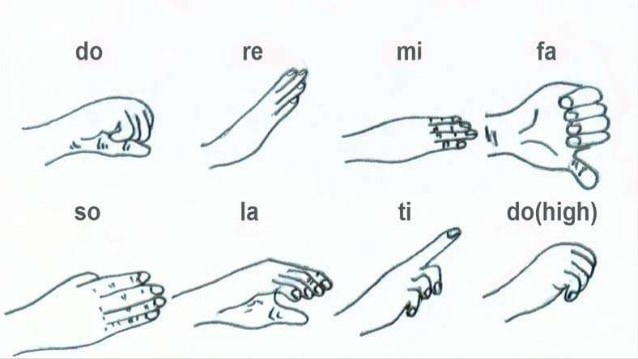Are you a new or experienced music teacher interested in using solfege hand signs?
Do you wonder what the big deal is about all of these waving hands?
Music teachers, especially those in elementary music or choir directors, should take a look at hand signs and how they can be used in your classroom.
Still, doubters may wonder:
What is the purpose of solfege hand signs?
Solfege, Curwen, or Kodaly hands signs are a system of hand symbols representing the different pitches in a tonal scale. They’re used to provide a physical association of a pitch system to help connect inner hearing and reading of pitches with musical performance.
Read on for more details on why teachers use hand signs and if they actually work.

Save time with these 60 FREE Music Resources to use in your room right away!
Stop searching the whole internet to find good activities. I’ll help you cut to the chase with my favorite 60 FREE resources.
Table of Contents
What Are Solfege Hand Signs?
Solfege hand signs, or more accurately Curwen hand signs, are hand movements which represent the different pitches in a scale.
Often, these are associated with the solfege pitches: do, re, mi, fa, sol, la, and ti.

These hand signs are also used at different height levels to show the relative pitch intervals between the solfege pitches.
- Do = in front of belly button
- Re = In front of chest
- Mi = Shoulder level
- Fa = Mouth level
- Sol = Eye level
- La = Forehead level
- Ti = Top of head level
- High Do = Just above head level
5 Reasons To Use Solfege Hand Signs
In this section, we’ll look at some of the main reasons teachers use solfege hand signs.
#1 Provides Movement Representing Pitch Intervals
Singing and hearing pitches can be a difficult thing to do and teach.
Many of us have horror stories from our sight singing and ear training classes. It can be hard to think about subjecting our students to the same thing.
But it doesn’t have to be that way!
Connecting an aural skill with different methods of learning can make developing this skill a lot easier (and more fun!).
Hand signs provide a kinesthetic way to show the aural skills. Teachers use these to help the brain build new roads to singing and reading skills.
The key to this purpose lay in the height difference you move to show each interval and the sign shape for each pitch.
#2 Encourages Inner Hearing
Many music teachers also use hand signs to help develop inner hearing or audiation. Inner hearing is when you can internalize the pitches you’re reading or thinking.
Hand signs give a tool for students to use while they hear inside, and teachers can use it to assess how well students are comprehending in an easy visual way.
Example 1:
Students look at a new melody and sign the pitches while singing inside. After signing, the students will sing the melody out loud.
Example 2:
Students sing a well-known pattern using solfege and hand signs. You tell the students to internalize all “do” pitches while still signing.
Continue by removing other pitches.
Example 3:
Students either create or read a flashcard with a pattern on it and sign it to a partner. The partner has to sing the pattern back.
#3 Gives A Different Avenue For Instruction
Newsflash: Students get bored.
Repeating the same kinds of activities and ways of teaching can get boring for your students and for you as the teacher. I often tell my students that I’m as easily distracted as they are.
Adding and taking away hand signs can be another way to get at the same problem of developing aural skills and sight singing. Mixing it up can be a great way to keep your students’ interest.
#4 Serves As A Useful Conducting Tool
Solfege hand signs are also a great conducting tool. Once students are comfortable when singing with them, you can challenge them to sing in harmony and signs make it a lot easier.
Not only can you lead them through scalular patterns with just showing them the signs, but you can also, with practice, split the class into two and have each class follow one of your hands as they sign different solfege.
This may seem like a crazy idea, but with a little practice (on their part and yours!) it can be a great and fun way to build part-work skills.
I did this earlier this year at a collegiate ACDA conference, and the students had a ball!
#5 It’s A Common Teaching Tool
C’mon…everyone’s doing it…
Well, maybe not everyone, but solfege hand signs are the most common way to physically represent solfege pitches.
The other two common ways being body signs and the hand staff.
They’ve been around for a long time (read the next section), so they’ve gained a solid footing as an instructional tool.
This being said, one of the reasons I teach it is also because if my students travel to another school or attend an honor’s choir of some sort, there’s a large chance they’ll come across it.
And if I want to give them the tools for success outside of my room, I want them to have some solid experience with these tools.
Do Solfege Hand Signs Work?
Surprisingly, there is some disagreement in this area. Some research has shown no statistical difference between those who use hand signs and those who don’t, but the bulk of teaching experience and other data collected from student experiences seems to indicate a benefit.
For example, Alan McClung did a study on the sight-singing scores of high school choristers with extensive training in movable do and Curwen hand signs. His results found no difference in the test scores of those who were allowed to use the hand signs and those without.
A good point against the study is that these students were all previously trained with hand signs, so it may be the benefit was already reaped. This also goes along with the point that hand signs aren’t the end goal in and of themselves.
In the research article submitted to Texas Music Education Research, Cousins and Persellin looked at the effect of Curwen hand signs on vocal accuracy of young children.
Over a course of 10 weeks first-grade students received instruction using solfege, but one class also used Curwen hand signs while the other didn’t.
Their average pretest was about the same, but both classes showed growth in the post-test. The Curwen hand sign class showed more growth by a small margin.
Though this research doesn’t clearly say how effective hand signs are, the authors suggest that the small difference in growth was due to the fact that, with hand signs, they were able to reach some of the more physical learners in their classroom and catch them up.
Takeaways
It may be that hand signs aren’t as effective for visual and aural learners, but if we want to reach all students, including those with a strong kinesthetic intelligence, we may wish to include hand signs to a certain degree.
There also reaches a certain point of higher skill where the act of doing hand signs may not be effective. However, it’s unclear what this point may be.
As a tool, solfege hand signs may be very useful with teaching singing skills and guiding activities, but they aren’t an end in and of themselves.
Wondering if music makes students get better grades? Check out this article and help advocate for your program.
Who Invented Solfege Hand Signs?
In the middle of the 19th Century, a British minister and choral director, John Curwen invented the system of hand signs.
Interestingly, he only focused on the diatonic 7 pitches (do, re, mi, fa, sol, la, ti) and didn’t emphasize chromatic alterations.
As to why he didn’t do those, it’s possibly due to the fact that once your students are adept at singing those alterations they may be at a level which doesn’t get as much benefit out of the motions.
Don’t forget: solfege and Curwen hand signs (this is the proper name) are just tools to the end of developing better sight singing and aural skills. The end goal is the ability to do this on their own.
What Are Kodaly Hand Signs?
Kodaly hand signs are the incorrect name of Curwen hand signs. When Zoltan Kodaly and his graduate students developed their teaching method to increase musical ability and appreciation in Hungary, they adopted the solfege hand signs as a way to help build sight singing and aural skills.
Favorite Resources
There are a few resources I use with hand signs and solfege. There are a lot of these you can find, but I’ve used these with success in my classroom.
(They’re also all on Amazon for often less than other places!)
Hal Leonard Kodaly Hand Sign Posters – Although the name is a little wrong, these posters are nice and engaging ones to put up and reference as you teach.
Melody Street – Melody Street (or Music Street, Solfa Boulevard, whatever you want to call it) is a time-honored Kodaly and solfege tradition. This cute book provides another way to introduce your solfege along with the hand signs.
Conversational Solfege Flashcards – Although Feierabend himself isn’t a big advocate for hand signs, these isolated flash cards are one of my bread butter resources when it comes to practicing solfege with hand signs.
Conclusion
Now you know all about the purpose of hand signs. Although the jury may be out on their actual effectiveness, the hand signs are an established tool which can serve different parts of your teaching.
Do you have another purpose for hand signs? What are your doubts on using them?
Hand signs and solfege are two powerful tools for improving singing and musicianship.
So is learning from experts at your own speed.
Save yourself some money and travel time by going through 30 Day Singer. (The “30 day” is much more than that.)

